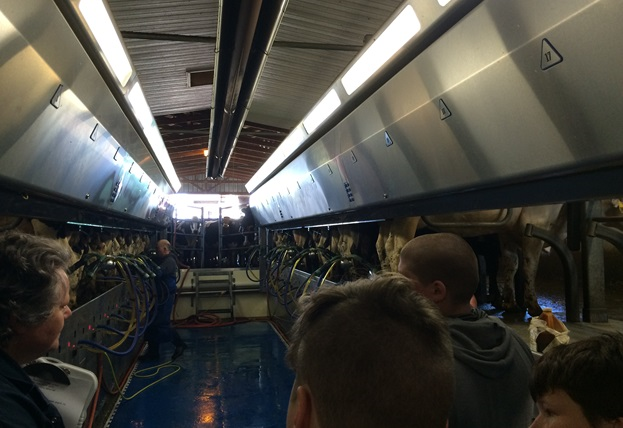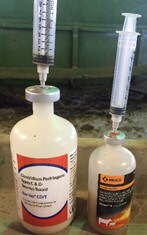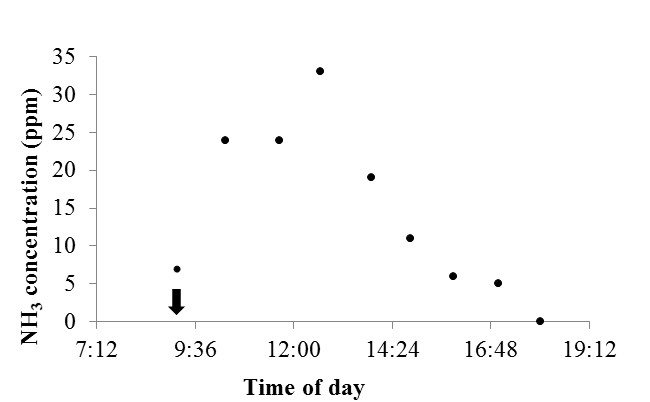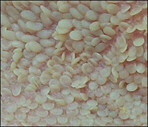June 2016 WSU Dairy Newsletter
Joe HarrisonAmber’s Top Ten Tips: Understanding Dairy FARM Evaluations
Approximately 90% of the milk supply in the United States currently participates in the National F.A.R.M. (Farmers Assuring Responsible Management) Program. Since its inception in 2009, the program’s participation has grown to include 82 co-ops and processors from across the nation. With the program’s increase in popularity, you most likely have already participated in an on-farm evaluation. I hope the information below will help you prepare for your next evaluation and encourage you to use some of the techniques below to monitor animal well-being on your dairy.
Last month, I completed the training to become a FARM Program on-farm evaluator. As I learned more about the program, I gained a deeper appreciation for how the program aims to emphasize “Animal Care is Everyone’s Responsibility”. Is the program perfect? No, but it is an honest attempt at uniting dairy industry stakeholders to achieve a common goal: provide the best care possible to dairy animals. These days, we need to unite as an industry in order to address the challenges that lie ahead.
Let’s take a closer look at the on-farm evaluation process and techniques evaluators use to monitor animal well-being:
-
Importance of On-farm Evaluations
Why do we conduct on-farm evaluations? What is the purpose? The basis of these evaluations is to assure consumers that dairy producers are providing optimal care to their animals and provide producers with resources to continually improve animal care.
-
Second-party Evaluation
These evaluations are conducted by certified evaluators like me that completed the FARM Program evaluator training. The process for these evaluations will be explained in-depth below. Over 33,000 second-party evaluations have been conducted.
-
Entrance Meeting
At the beginning of each second-party evaluation, the evaluator will ask you a series of questions about your farm. This is a perfect time for you to ask questions about the FARM program. Once the meeting concludes, the evaluator will proceed to the cow housing facilities to collect cow observation data.
-
Hygiene Scores
Cows are scored on a scale of 1 – 4, with a 1 representing a clean cow and a 4 representing a cow that has manure on her udder/belly and up towards her back. The goal is to have at least 90% of observed animals with a score of 2 or lower.
-
Locomotion Scores
The locomotion scoring system is on a scale of 1 – 3, with a 1 representing a cow sound on all four legs and a 3 representing a severely lame cow. The goal is to have at least 95% of observed animals with a score of 2 or lower.
-
Body Condition Scores
Body condition is analyzed by using a scale of 1 – 5, with a 1 representing a cow with no fat cover over her tail head, short ribs, hooks or pins and a 5 representing an obese cow. The goal is to have at least 99% of observed animals with a score of 2 or higher.
-
Hock and Knee Lesion Scores
Hock and knee lesion scores are evaluated on a scale of 1 – 3, with a 1 representing a cow that has hair loss less than the size of a quarter with no swelling and a 3 representing a cow with severe swelling and/or an abrasion. The goal is to have at least 95% of observed cows with a score of 2 or lower.
-
Closing Meeting
After the evaluator completes his/her animal observations, the evaluation will conclude with a closing meeting. The evaluator will discuss the observations with you, share any recommended areas for improvement, and, if needed, develop a corrective plan with you. Once again, consider this meeting to be an excellent opportunity to ask questions.
-
Third-party Verification
To maintain the integrity of the FARM program, a third-party (in this case, a company called Validus) selects a random sample of evaluated farms to verify each year. The objective is to test whether the third-party evaluators reach the same conclusions as the second-party evaluators. Approximately 750 third-party verifications have been completed.
-
Effectiveness of the Program
A 3% improvement in cow hygiene cores occurred from 2014 to 2015, in addition to a 2% improvement in locomotion scores and a 4% improvement in hock and knee lesions.
For more information (including charts on scoring hygiene, locomotion, and body condition) visit http://www.nationaldairyfarm.com/animal-care-program

Interested about the future of water in the PNW?
Join us for the Climate Impacts to Water Conference: Managing the Uncertainties of Water Supply and Quality in the PNW
The PNW’s $21.8 billion agricultural sector ($13.2 billion for crops and $8.6 billion for animals; USDA-NASS, 2013) is vulnerable to risks associated with climate change, especially, increased pressures on water resources in arid environments because of its reliance on regional climatic factors. Severe droughts are projected in semiarid regions of the U.S. during the upcoming century (Ault et al., 2014; Steinemann, 2014). Annual average temperatures in the PNW are projected to increase by 3.3 to 9.7° F by the end of the century and availability and timing of precipitation is also expected to shift (Mote et al., 2014). Excessive spring precipitation, longer freeze-free seasons, decreases in mountain snowpack, and reduced stream flow could also reduce available water, and further stress agricultural production and management (Mote et al., 2014; Abatzoglou et al., 2014; DOE, 2011).
In the PNW, seasonal variations in water supply and demand of the Columbia River Basin have resulted in localized water shortages that are expected to increase with competing demands for fresh water resources into the future (DOE, 2011). To reduce negative economic, social and environmental consequences associated with drought, agricultural producers, advisors and managers must be better informed about regional climate projections (immediate and long-term), on-farm water management, and conservation opportunities. There is a two day upcoming regional conference—Climate Impacts to Water: Managing the Uncertainties of Water Supply and Quality—occurring on January 25-26 at Skamania Lodge in Stevenson, WA. Regional agricultural producers, agriculture professionals, consultants, educators and specialists, NRCS, local and state employees and others interested in the topic are invited to more about the consequences and management of water in the PNW. Because agricultural advisors and similar stakeholders serve as key resources to producers for information about risks and management, increasing awareness and accessibility to relevant resources through this PNW Climate Impacts to Water conference will improve abilities to address concerns about sustainable water management, and risks to production systems and local environments.
The objectives of this conference are to:
- Improve your understanding about projected climate impacts on water accessibility in the PNW, and learn about sustainable management decisions.
- Create awareness of resources for adopting strategies that will make farming operations more resilient to climate change, while minimizing impact.
- Build on the regional network of advisors and educators and take the knowledge gained at the conference and encourage adoption in the field
The areas of emphasis are:
- Regional projections of climate and water supply
- Multiple facets of water management, including agricultural and stormwater
- Water conservation practices
- Water policy, regulations and rights
- Water quality
- Social science communication concerning water
Registration and abstract information will be announced by July, 2016. To learn more about this regional effort, please contact Liz Whitefield e.whitefield@wsu.edu or visit: cm.wsu.edu/climateimpactstowaterconference
Cited Resources
- Abatzoglou, J.T., D.E. Rupp and P.W. Mote. 2014. Seasonal climate variability and change in the Pacific Northwest of the United States. Journal of Climate. 27:2125-2142. doi:10.1175/JCLI-K-13-00218.1.
- Ault, T.R., J.E. Cole, J.T. Overpeck, G.T. Pederson and D.M. Meko. 2014. Assessing the risk of persistent drought using climate model simulations and paleoclimate date. Journal of Climate. doi:10.1175/JCLI-D-12-00282.1. In press.
- Department of Ecology (DOE). 2011. Columbia River Basin: Long-term water supply and demand forecast. Washington State Legislative Report 11-12-011. [Online]. Available at: http://www.ecy.wa.gov/biblio/11-12-011.
- Mote, P., A.K., Snover, S. Capalbo, S.D. Eigenbrode, P. Glick, J. Littell, R. Raymondi and S. Reeder. 2014. Ch. 21: Northwest. Climate change impacts in the United States: The third national climate assessment. J.M. Melillo, Terese (T.C.) Richmond, and G.W. Yohe (Eds.).U.S. Global change Research Program:487-513. doi:10.7930/J04Q7RWX. [Online]. Available at: http://nca2014.globalchange.gov/report/regions/northwest. Accessed: 2014, October 9.
- United States Department of Agriculture National Agricultural Statistics Service (USDA-NASS). 2013. State agriculture overview (WA, OR and ID). [Online]. Available at: www.nass.usda.gov/Quick_Stats/.
- Steinemann, A. 2014. Drought information for improving preparedness in the western states. American Meteorological Society Bulletin:843-847. doi:10.1175/BAMS-D-13-00067.1

Celebrating—and Learning—during Dairy Month
On June 16-17, 2016, 96 Anacortes Junior High School students, teachers, and chaperones visited the Vander Kooy Harmony Farm #2 in Mount Vernon, WA. This visit was coordinated by WSU Skagit County Extension and included 4-H staff, a Master Gardener volunteer, and WSU faculty. Representatives of the Washington State Dairy Ambassador program also participated.
Each tour day featured one busload of students in the morning and another in the afternoon; many special needs students participated. Each group of students was divided into four sub-groups that rotated between four learning stations:
Station 1: Crops and soils discussion and demonstration.
WSU Skagit County Extension Director Don McMoran taught students about soil types, soil health, typical local crops, and how manure can benefit soil fertility and health. He sent each group home with a canning jar of soil suspended in water and instructed them to set it in their classroom and watch what happens as the particles settle. The students were eager to do this.
Station 2: Insect demonstration.
WSU Master Gardener Virgene Link brought an impressive array of preserved insect specimens to share with the students. She highlighted how most insects are non-problematic or even beneficial and we should not just reach for the “bug spray” when we see an insect. Students enjoyed looking at insects under a microscope and with magnifying glasses.
Station 3: Tools of the trade.
With assistance from advisor Annie Lohman, 2016-17 Skagit County Dairy Ambassador Juliana LeClair and Alternate Dairy Ambassador Leanna DeVries engaged students with a selection of the tools and used on a dairy farm. Students were introduced to water floats, moisture meters, A.I. straws, pH meters, esophageal feeders, OB chains, and balling guns to name just a few.
Station 4: Dairy cow milking, feeding, and welfare.
WSU Livestock and Dairy Extension Specialist Susan Kerr explained modern milking practices while students watched the process in the milking parlor. They learned about milk’s journey from cow to table, steps to insure milk safety and quality, and a cow’s lifecycle of production. They watched cows willingly enter the parlor and stand quietly for milking. Next they went to the freestall housing area and watched cows eat their TMR, relax, interact, ruminate, and make milk. Ways farmers keep cows comfortable, clean, healthy, and productive were highlighted.
Some questions, comments, or myths addressed during the tour included: “I heard boy calves are killed at birth;” “My mother says things are added to milk to make it taste unnatural;” “I heard that pasteurization destroys the nutrition in milk;” “Cows only have molar teeth;” and a favorite, “Is it true that a cow could eat a human?”
Tour participants left the farm knowing where dairy products come from, what it takes to make milk, and how much producers care about cow comfort and welfare. They saw firsthand how technology and mechanization have made farms more efficient and productive, keeping food prices low. Students learned how American dairy farmers feed the U.S. and the world.
Although time consuming and a bit of an inconvenience on a working farm, such educational tours can go a long way toward dispelling common myths and misunderstandings about dairy production. If you are interested in partnering with a school in your area to host such an event and need some assistance, please contact Susan Kerr at 360-848-6151 or kerrs@wsu.edu.
Thank you, Vander Kooy family!




























